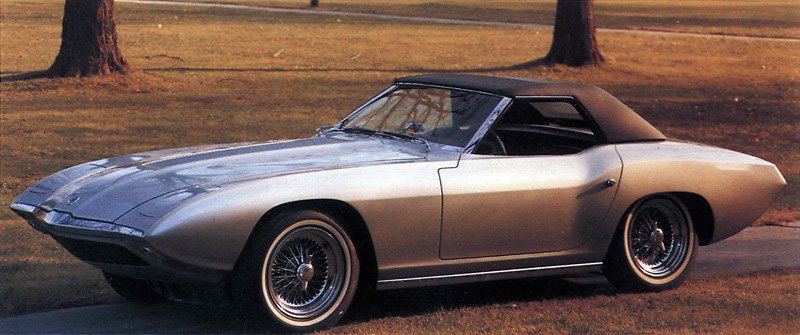Description
The Ford Bordinat Cobra was one of the most eye-catching concept cars of the 1960s, created in 1965 as a design exercise under the direction of Eugene “Gene” Bordinat, then Ford’s Vice President of Design. Intended as both a styling study and a potential replacement for the Shelby Cobra, the Bordinat Cobra showcased Ford’s exploration of futuristic design themes while still hinting at its ties to racing and high performance.
From the outside, the Bordinat Cobra was radical and dramatic, even by concept car standards. Its body was extremely low and wide, with exaggerated curves and flowing lines that gave it an almost organic, sculpted appearance. The front end featured a rounded nose with integrated headlamps under clear covers, while the sides swept into muscular rear haunches that housed large wheels and tires. The cockpit was set far back, emphasizing the long, flowing hood and creating proportions that echoed Italian exotics of the period. The rear was equally striking, with a high tail and thin horizontal lights, completing the impression of a futuristic sports car.
The body of the Bordinat Cobra was constructed from fiberglass, and its proportions were extreme even by concept standards. Its low stance and aerodynamic form were meant to preview potential design directions for future sports cars, pushing the boundaries of what Ford’s styling department could imagine. The car was sometimes referred to as the “XD Cobra,” linking it conceptually to Ford’s experimental design program.
Inside, the Bordinat Cobra was minimalist and futuristic. The two-seat cockpit featured low bucket seats, a dramatic wraparound dash, and unconventional switchgear. Unlike the production Shelby Cobra’s spartan interior, this was more of a showpiece, designed to dazzle crowds at auto shows rather than provide practical comfort. It reflected Bordinat’s emphasis on design as a spectacle and a vision of the future.
Mechanically, the Bordinat Cobra was less advanced than its looks suggested. While it borrowed ideas from Ford’s performance programs, it was primarily a non-running show car and not intended for full-fledged racing development. However, its connection to the Shelby Cobra project gave it legitimacy as more than just a fantasy. Bordinat envisioned it as a possible next step in Ford’s sports car lineage, a more refined and exotic counterpart to Carroll Shelby’s raw and muscular Cobra roadsters.
The Bordinat Cobra was shown on the auto show circuit in the mid-1960s, where it generated considerable attention for its extreme styling. However, Ford never had serious plans to put it into production. By that time, the company’s performance efforts were focused on the GT40 at Le Mans and the Mustang for the showroom, leaving little room for an exotic two-seat coupe. The Bordinat Cobra remained a one-off vision, an exploration of design rather than a prelude to a production car.
Today, the Ford Bordinat Cobra is remembered as one of the most flamboyant and daring concept cars of its era. Though it never progressed beyond the show car stage, it demonstrated Ford’s willingness to push stylistic boundaries and reinforced the Cobra’s image as a platform not just for performance but also for bold design experimentation. Surviving photographs and the preserved car itself highlight its importance as part of Ford’s 1960s design heritage, standing as a striking reminder of an era when concept cars were created to inspire, excite, and test the limits of automotive imagination.
